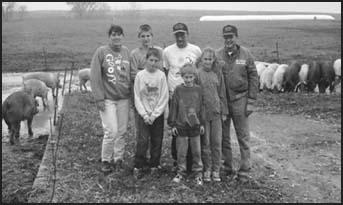 A FFA project which started with two sows when Steve Nietfeld was 16, has grown to about 200 sows in a farrow to finish operation.
A FFA project which started with two sows when Steve Nietfeld was 16, has grown to about 200 sows in a farrow to finish operation.Nietfeld lives west of Lake Henry and raises Yorkshires, Hampshires, and Duroc pigs.
Nietfeld took over the swine operation from his dad, Ray. “I started raising swine in 1961. It seems like there have always been pigs on the place,” Ray said. “I only had 10 to 12 hogs at that time. They required a lot more work than now,” he added. “Everything was done by hand and not by machine.”
Ray, a former milk truck driver, has switched from the swine production to dairy and today milks 61 Holsteins.
Steve Nietfeld said he farrows his sows twice a year. Each litter averages nine piglets. He uses Yorkshire sows as they produce better milk and take better care of their little ones.
“I usually farrow eight to 11 sows a week in the farrowing barn,” Nietfeld said. Nietfeld has two farrowing barns, one has 22 crates and the other 33 crates. All the crates are lined with rubberized mats to ensure better footing for the sows. The mats also help keep the sows cleaner,” he added.
When the piglets reach four weeks of age, they are literally carried to the nursery where they will stay another four weeks. There are 16 pens in the nursery and each pen will hold anywhere from 20 to 25 pigs, depending on their size.
From the nursery, the piglets are moved into a grower barn where they will stay until they reach about 80 pounds. The grower barn has six pens which hold about 60 pigs each.
Their last stop is the finishing barn which is located on another farm a few miles away. They are kept in the finishing barn until they weigh between 250 and 270 pounds.
Nietfeld said it takes about six months to raise the piglet from birth to market then they start all over again. “The work never quits,” he added.
Nietfeld said the farm is a family affair. Their children’s chore are: Aaron, 13, is responsible for feeding the sows in the gestation barn; Cory, 10, and Kristen, 11, help feed grandpa Ray’s calves and Nathan, 8, helps mom and dad feed the pigs. Nathan says he enjoys chasing the pigs and catching rides on the bigger ones.
The sows are fed a ration of corn and concentrate mixture while in the nursery and as they grow bigger it is cut ration is decreased.
All the barns (six total on the home place) drain to a manure pit which is emptied twice a year. The pit holds about 300,000 gallons of liquid manure.
Nietfeld has what is called a closed herd which means he doesn’t bring any new hogs onto the farm place. He artifically breeds his sows to get new breeding stock. Nietfeld said he changes sows every two years or after five litters. “After two litters you can tell if the sows are going to be good mothers or not,” he said. “If the sows aren’t good mothers, they are shipped to Swift at Willmar or the IBP plant at Litchfield.”
The hog prices aren’t the greatest right now, 28 cents per pound. “We’re not making much, but we’ll hang in there and hopefully the prices will improve,” Nietfeld said.
Nietfeld said he enjoys farming because a person can set his own schedule, the hours are flexible and you are your own boss.
Pork producers have a long history of working hard to obtain a better product, according to Donna Reifschneider, president of the National Pork Producers Council.
The pork checkoff program has helped producers raise a better product and adjust to a rapidly changing industry. The checkoff program was started in 1986 and has collectively generated greater consumer promotion and production research.
“The United States produces the world’s best pork in terms of quality, low cost and consistent supply,” Karl Johnson, Minnesota pork producer, said.
During the past decade, pork exports have made a significant contribution to the profitability of U.S. pork producers. Exports contributed $1.95 billion, or $2.36 per market hog to producer revenues during the period. The trend toward expanding pork exports is continuing.
Did you know?
•Pork is the world’s most widely consumed meat. Pork accounts for 40 percent of the world’s meat consump-tion
•The U.S. pork industry is a multi-billion dollar industry that employs an estimated 600,000 people.
•Iowa ranks #1 in the number of hogs produced annually. Rounding out the top five states are North Carolina, Minnesota, Illinois and Indiana.
•The number one customer of U.S. pork is Japan, according to 1997 USDA data.
•Typical farrow-to-finish operation had profits averaging more than $10 per hog in the decade ending 1996.
•In 1997, the U.S. pork industry exported more than $1 billion worth of pork products.